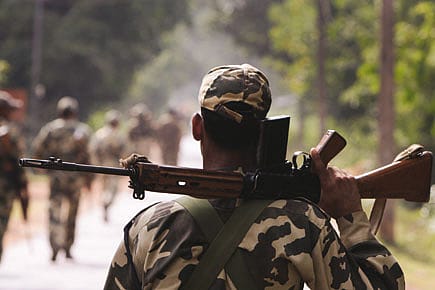Olive Green in Red Zones

The Indian Army stiffens its anti-Maoist operations. But at what cost?
In the past few months, the Centre has dithered on the issue of deploying the Army in Maoist-affected areas. Though the Home Ministry has been keen on the Army's direct engagement of Maoists, the force's top brass, backed by the Defence Ministry, has maintained that deployment in these areas will over-stretch a force that is already active in other theatres of insurgency, such as Kashmir and the Northeast. But now it seems that the Army is gradually raising its involvement in anti-Maoist operations. In a significant development, the force has selected a vast tract of land very close to a 'liberated zone' of Maoists in Chhattisgarh to establish a training facility. Though the Defence Ministry has emphasised that the Army's role will be restricted to training, it is believed that it will position a large number of troops in this area, ensuring a garrison kind of presence. Incidentally, the training facility will be very close to where Maoists carried out their biggest attack against State forces so far—on 6 April this year, when they killed 75 CRPF personnel in an ambush.
The Army has been indirectly involved in anti-Maoist operations for some time now. A surrendered Maoist guerilla, who is now a special police officer in Chhattisgarh, recently disclosed that 30 of them were flown in to Kashmir to train with the force. The Army has so far trained many batches of police and paramilitary forces to enable them to deal more effectively with Maoist threats. The Lucknow-based Central Command of the Indian Army has reportedly devised a special training plan to get soldiers acquainted with the kind of jungle warfare Maoist guerillas specialise in. Thousands of troops will be trained under this plan. Unlike the operational methodology adopted by the paramilitary forces so far, the Army strategy involves advancing in grid-like formations and isolating civilian populations. The Army has also announced the setting up of a sub-area command in Chhattisgarh. The force had so far no presence in the state. Sources believe that the Army wants to be prepared for any eventuality if the Centre orders them deployed in Maoist-affected areas. The Army has been stressing, though, that in current circumstances it will be difficult to operate in these areas. It wanted these areas to be declared as 'disturbed' and the Armed Forces Special Powers Act imposed before moving in.
In July this year, a press release by the Defence Ministry quoted Army Chief General VK Singh as telling officers to "be mentally prepared to step into the fight against Naxalism" if the situation on the ground did not improve. A few hours after its release, the statement was withdrawn by the Defence Ministry. Veteran Army officers have, in the recent past, termed plans of such an engagement with Maoists 'unwise'. But defence analysts believe that counter-Maoist operations need to be seen in two dimensions. Says senior defence analyst Rahul Bhonsle: "The Army has no role in the politico-security aspect of Maoism, which is being employed at present across the larger spreads. It needs to be met by the police and paramilitary with a differential political strategy, where the Army has no role and will be most uncomfortable adjusting to the political dimensions. However, the PLGA (Maoist army) strongholds in Abujhmaad (Maoist 'liberated zone') can be taken out only by the Army. Though there is also an option of winkling out the PLGA from its lair by using only the paramilitary and whittling away at their strength, I doubt if we have the creative imagination to use such a strategy." However, he also cautions that the Army needs to take a call on deployment in these areas since it will take a toll on modernisation of the force. "For every year you employ the Army for counter-Naxal operations, you will lose six months of modernisation time. So a call on this needs to be taken with a larger perspective," he says.
This is one aspect that the Army will have to factor in before promising heavier involvement in anti-Maoist operations. After all, it has to take into account its future preparedness—vis-a-vis both China and Pakistan.
